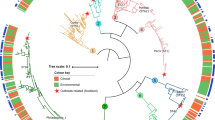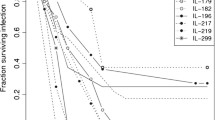Abstract
Legionella pneumophila is a strict intracellular pathogen that replicates in the professional phagocytes of the human and guinea pig host. Although murine macrophages from most inbred strains are non-permissive to intracellular replication of L. pneumophila, inflammatory macrophages from the mouse strain A/J are completely permissive to intracellular replication of this bacterium. This genetic difference is controlled by the expression of a single autosomal gene designated Lgn1, with non-permissiveness behaving as completely dominant over permissiveness. We have used a total of 25 AXB/BXA recombinant inbred mouse strains and 182 (A/JxC57BL/6J)xA/J segregating backcross progeny (A/J, permissive; C57BL/6J, non-permissive) to map the Lgn1 gene. Animals were individually type for tolerance to intracellular replication by in vitro infection of their inflammatory macrophages with L. pneumophila. All animals segregated into two non-overlapping groups. Examination of the strain distribution pattern of the AXB/BXA strains for Lgn1 initially identified linkage to Chromosome (Chr) 13 markers. Genotyping of the 25 AXB/BXA strains and the 182 backcross progeny for 11 Chr 13 markers established that Lgn1 mapped to Chr 13, with the gene order and intergene distance D13Mit231-(5.5±1.5)-D13Mit193-(2.2±0.9)-D13Mit194-(1.1±0.6)-D13Mit128-(2.6±1.0)-Lgn1-(2.2±0.9)-D13Mit70-(3.9±1.3)-D13Mit73-(7.2±1.7)-D13Mit53-(0.7±0.5)-D13Mit32-(0.7±0.5)-D13Mit77-(0.7±0.5)-D13Mit78. This portion of Chr 13 is homologous to the distal portion of human Chr 5, 5q11–5q13, suggesting a possible location of a human LGN1 homolog. Understanding the molecular basis of the high permissiveness of A/J macrophage to L. pneumophila may shed light on the survival strategy of this bacterium in highly permissive human phagocytes. This may be achieved by positional cloning of Lgn1, and the identification of the Lgn1 subchromosomal region reported here is a first step towards that goal.
Similar content being viewed by others
References
Boraschi, D., Meltzer, M.S. (1979). Defective tumoricidal capacity of macrophages from A/J mice. J. Immunol. 122, 1587–1591.
Bradley, D.J., Taylor, B.A., Blackwell, J., Evans, E.P., Freeman, J. (1979). Regulation of Leishmania populations within the host III. Mapping of the locus controlling susceptibility to visceral Leishmaniasis in mice. Clin. Exp. Immunol. 37, 7–14.
Brieland, J.K., Freeman, P.T., Remick, D.G., Hurley, M.C., Fantone, J.C., Engleberg, N.C. (1994) Endogenous tumor necrosis factor alpha (TNF-α) and gamma interferon (IFN-γ) facilitate resolution of replicative Legionella pneumophila lung infection in A/J mice. J. Leukoc. Biol. (suppl.), S31.
Byrd, T.F., Horwitz, M.A. (1989). Interferon gamma-activated human monocytes down regulate transferrin receptors and inhibit the intracellular multiplication of Legionella pneumophila by limiting the availability of iron. J. Clin. Invest. 83, 1457–1465.
Byrne, G.I., Faubion, S.L. (1982). Lymphokine-mediated microbiostatic mechanisms restrict Chlamydia psittaci growth in macrophages. J. Immunol. 128, 469–474.
Cheers, C., McKenzie, L.F.C. (1978). Resistance and susceptibility of mice to bacterial infection: genetics of listeriosis. Infect. Immun. 19, 755–762.
Davis, G.S., Winn, W.C., Beaty, H.N. (1981). Legionnaires' disease. Infections caused by Legionella pneumophila and legionella-like organisms. Clin. Chest Med. 2, 145–166.
Dietrich, W.F., Kalz, H., Lincoln, S.E., Shin, H.-S., Freidman, J., Dracopoli, N.C., Lander, E.S. (1992). A genetic map of the mouse suitable for typing intraspecific crosses. Genetics 131, 423–447.
Dietrich, W.F., Miller, J.C., Steen, R.G., Merchant, M., Damron, D., Nahf, R., Gross, A., Joyce, D.C., Wessel, M., Dredge, R.D., Marquis, A., Stein, L.D., Goodman, N., Page, D.C., Lander, E.S. (1994). A genetic map of the mouse with 4006 simple sequence length polymorphisms. Nature Genet. 7, 220–245.
Douville, P., Seldin, M.F., Carbonetto, S. (1992). Genetic mapping of the integrin α1 gene (Vla1) to mouse chromosome 13. Genomics 14, 503–505.
Elliot, J.A., Winn, W.C. (1986). Treatment of alveolar macrophages with cytochalasin D inhibits uptake and subsequent growth of Legionella pneumophila. Infect. Immun. 51, 31–36.
Forget, A., Skamene, E. (1985) Genetic regulation of early host defense mechanisms controlling mycobacterial infection. In Genetic Control of Host Resistance to Infection and Malignancy, E. Skamene, ed., (New York: Alan R. Liss), pp. 265–277.
Frankel, W.N., Stoye, J.P., Taylor, B.A., Coffin, J.M. (1989). Genetic identification of endogenous polytropic proviruses by using recombinant inbred mice. J. Virol. 63, 3810–3821.
Fraser, D.W., Tsai, T.R., Orenstein W. (1977). Legionnaires' disease. Description of an epidemic of pneumonia. N. Engl. J. Med. 297, 1189–1197.
Fujio, H., Yoshida, S., Miyamoto, H., Mitsuyama, M., Mizuguchi, Y. (1992). Investigation of the role of macrophages and endogenous interferon-γ in natural resistance of mice against Legionella pneumophila infection. FEMS Microbiol. Immunol. 89, 183–191.
Funanage, V.L., Myoda, T.T., Moses, P.A., Cowell, H.R. (1984). Assignment of the human dihydrofolate reductase gene to the q11–q12 region of chromosome 5. Mol. Cell. Biol. 4, 2010–2016.
Gervais, F., Stevenson, M., Skamene, E. (1984) Genetic control of resistance to Listeria monocytogenes: regulation of leukocyte inflammatory responses by the Hc locus. J. Immunol. 132, 2078–2083.
Glick, T.H., Gregg, M.B., Berman, B., Mallison, G.F., Rhodes, W.W. Jr., Kassanoff, L. (1978). Pontiac fever: an epidemic of unknown etiology in a health department. I. Clinical and epidemiologic aspects. Am. J. Epidemiol. 107, 149–160.
Gros, P., Skameue, E., Forget, A. (1981). Genetic control of natural resistance to Mycobacterium bovis (BCG) in mice. J. Immunol. 127, 2417–2421.
Groves, M.G., Rosenstreich, D.L., Taylor, B.A., Osterman, J.V. (1980). Host defenses in experimental Acrub typhus: mapping of the gene that controls natural resistance in mice. J. Immunol. 125, 1395–1402.
Horwitz, M. (1983). Symbiotic interactions between Legionella pneumophila and human leukocytes. Int. Rev. Cytol. Suppl. 14, 307–328.
Horwitz, M.A., Maxfield, F.R. (1984). Legionella pneumophila inhibits acidification of its human monocytes. J. Cell Biol. 99, 1936–1943.
Horwitz, M.A., Silverstein, S.C. (1980). The legionnaires' disease bacterium (Legionella pneumophila) multiples intracellularly in human monocytes. J. Clin. Invest. 66, 441–450.
Humphries, S.E., Tata, F., Henry, I., Barichard, F., Holm, M., Junien, C., Williamson, R. (1985). The isolation, characterization and chromosomal assignment of the gene for human 3-hydroxy-3-methylglutaryl coenzyme A reductase (HMG-CoA reductase). Hum. Genet. 71, 254–258.
Jacobs, R.E., Locksley, R.M., Wilson, C.B., Haas, J.E., Klebanoff, S.J. (1984). Interaction of primate alveolar macrophages and Legionella pneumophila. J. Clin. Invest. 73, 1515–1523.
Justice, M.J., Stephenson, D.A. (1994). Mouse chromosome 13. Mamm. Genome 5(Suppl.), S196-S206.
Katz, S.M., Matus, J.P. (1985). Animal models of legionellosis, InLegionellosis, vol. 2, S.M. Katz, ed. (Boca Raton, Fla.: CRC Press, Inc.), pp. 119–132.
Kishimoto, R.A., Kastello, M.O., White, J.D., Shirey, F.G., McGann, V.G., Larson, E.W., Hedlung, K.W. (1979). In vitro interaction between normal cynomologus monkey alveolar macrophages and Legionnaires' disease bacteria. Infect. Immun. 25, 761–763.
Kishimoto, R.A., White, J.D., Shirey, F.G., McGann, V.G., Berendt, R.F., Larson, E.W., Hedlund, K.W. (1981). In vitro response of guinea pig peritoneal macrophages to Legionella pneumophild. Infect. Immun. 31, 1209–1213.
Klein, T.W., Yamamoto, Y., Brown, K., Friedman, H. (1991). Interferongamma induced resistance to Legionella pneumophila in susceptible A/J mouse macrophages. J. Leukoc. Biol. 49, 98–103.
Kosambi, D.D. (1944). The estimation of map distances from recombination values. Ann. Eugen. 12, 172–175.
Kura, F., Suzuki, K., Watanabe, H., Akamatsu, Y., Amano, F. (1994). Difference in Legionella pneumophila growth permissiveness between J774.1 murine macrophage-like JA-4 cells and lipopolysacharide (LPS)-resistant mutant cells, LPS1916, after stimulation with LPS. Infect. Immun. 62, 5419–5423.
Lemons, R.S., Espinosa, R., Rebentisch, M., McCormick, F., Ladner, F.M., Le Beau, M.M. (1990). Chromosomal localization of the gene encoding GTPase-activating protein (RASA) to human chromosome 5, ands q13–q15. Genomics 6, 383–385.
Lien, L.L., Boyce, F.M., Kleyn, P., Brzustowicz, L.M., Menninger, J., Ward, D., Gilliam, T.C., Kunkel, L. (1991). Mapping of human microtubule-associated protein 1B in proximity to the spinal muscular atrophy locus at 5q13. Proc. Natl. Acad. Sci. USA 88, 7873–7876.
McDade, J.E., Shepard, C.C., Fraser, D.W., Tsai, T.R., Redus, M.A., Dowdle, W.R., the Laboratory Investigation Team (1977). Legionnaires' disease. Isolation of a bacterium and demonstration of its role in other respiratory disease. N. Engl. J. Med. 297, 1197–1203.
Meltzer, M.S., Occchionero, M., Ruco, L.P. (1982). Macrophage activation for tumor cytotoxicity: regulatory mechanisms for induction and control of cytotoxic activity. Fed. Proc. 41, 120–127.
Nanciel, C., Ronco, E., Deschenes, M., Guenounou, M. (1985). Immuneresponse during infection with a temperature-sensitive mutant of Salmonella typhimurium in susceptible and resistant mice. In Genetic Control of Host Resistance ot Infection and Malignancy, E. Skamene, ed. (New York: Alan R. Liss), pp. 257–264.
Nash, T.W., Libby, D.M., Horwitz, M.A. (1984). Interaction between the Legionnaires' disease bacterium (Legionella pneumophila) and human alveolar macrophages. Influence of antibody, lymphokines, and hydrocortisone. J. Clin. Invest. 74, 771–782.
Neumann, P.E. (1990). Two-locus linkage analysis using recombinant inbred strains and Bayes' theorem. Genetics 126, 277–284.
Plant, J., Glynn, A.A. (1976). Genetics of resistance to infection with Salmonella typhimurium in mice. J. Infect. Dis. 133, 72–78.
Silver, J. (1985). Confidence limits for estimates of gene linkage based on analysis of recombinant inbred strains. J. Hered. 76, 436–440.
Skamene, E., Kongshavn, P.A.L., Sacks, D.H. (1979). Resistance to Listeria monocytogenes in mice is genetically controlled by genes which are not linked to the H-2 complex. J. Infect. Dis. 139, 228–231.
Skamene, E., Gros, P., Forget, A., Kongshavn, P.A.L., St. Charles, C., Taylor, B.A. (1982). Genetic regulation of resistance to intracellular pathogens. Nature 297, 506–509.
Smouse, P.E. (1988) Combining genetic information from two-point testcrosses and recombinant inbred lines. 79, 478–479.
Stevenson, M.M., Kongshavn, P.A.L., Skamene, E. (1981). Genetic link-age of resistance to Listeria monocytogenes with macrophage inflammatory responses. J. Immunol. 127, 402–407.
Summersgill, J.T., Powell, L.A., Buster, B.L., Miller, R.D., Ramirez, J.A. (1992). Killing of Legionella pneumophila by nitric oxyde in γ-interferon activated macrophages. J. Leukoc. Biol. 52, 625–629.
Vidal, S., Malo, D., Vogan, K., Skamene, E., Gros, P. (1993). Natural resistance to infection with intracellular parasites: isolation of a candidate for Beg. Cell 73, 469–485.
Watson, J., Riblet, R. (1974). Genetic control of responses to bacterial lipopolysaccharides in mice. I. Evidence for a single gene that influences mitogenic and immunogenic responses to lipopolysaccharides. J. Exp. Med. 140, 1147–1161.
Watson, J., Kelly, K., Largen, M., Taylor, B.A. (1978). The genetic mapping of a defective LPS response gene in C3H/HeJ mice. J. Immunol. 120, 422–424.
Weiffenbach, B., Falls, K., Bricker, A., Hall, L., McMahon, J., Wasmuth, J., Funanage, V., Donis-Keller, H. (1991). A genetic linkage map of human chromosome 5 with 60 RFLP markers. Genomics 10, 173–185.
Yamamoto, Y., Klein, T.W., Newton, C.A., Widen, R., Friedman, H. (1987). Differential growth of Legionella pneumophila in guinea pig versus mouse macrophage cultures. Infect. Immun. 55, 1369–1374.
Yamamoto, Y., Klein, T.W., Newton, C.A., Widen, R., Friedman, H. (1988). Growth of Legionella pneumophila in thioglycolate-elicited peritoneal macrophages from A/J mice. Infect. Immun. 56, 370–375.
Yamamoto, Y., Klein, T.W., Friedman, H. (1991). Legionella pneumophila growth in macrophages from susceptible mice is genetically controlled. Proc. Soc. Exp. Biol. Med. 196, 405–409.
Yamamoto, Y., Klein, T.W., Friedman, H. (1992). Genetic control of macrophage susceptibility to infection by Legionella pneumophila. FEMS Microbiol. Immunol. 89, 137–146.
Yamamoto, Y., Klein, T.W., Friedman, H. (1994). Legionella and macrophages. (Review) Immunol. Ser. 60, 329–348.
Yoshida, S.-l., Mizuguchi, Y. (1986). Multiplication of Legionella pneumophila Philadelphia-1 in cultured peritoneal macrophages and its correlation to susceptibility of animals. Can. J. Microbiol. 32, 438–442.
Yoshida, S.-I., Goto, Y., Mizuguchi, Y., Nomoto, K., Skamene, E. (1991a). Genetic control of natural resistance in mouse macrophages regulating intracellular Legionella pneumophila replication in vitro. Infect. Immun. 59, 428–432.
Yoshida, S.-I., Goto, Y., Miyamoto, H., Fujio, H., Mizuguchi, Y. (1991b). Association of Lps gene with natural resistance of mouse macrophages against Legionella pneumophila. FEMS. Microbiol. Immunol. 89, 51–56.
Author information
Authors and Affiliations
Rights and permissions
About this article
Cite this article
Beckers, MC., Yoshida, Si., Morgan, K. et al. Natural resistance to infection with Legionella pneumophila: chromosomal localization of the Lgn1 susceptibility gene. Mammalian Genome 6, 540–545 (1995). https://doi.org/10.1007/BF00356173
Received:
Accepted:
Issue Date:
DOI: https://doi.org/10.1007/BF00356173




